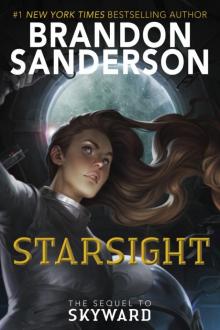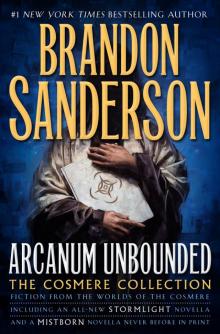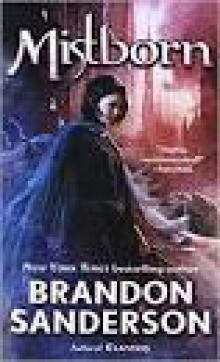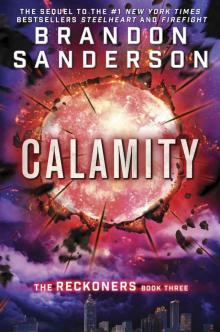- Home
- Brandon Sanderson
Arcanum Unbounded: The Cosmere Collection
Arcanum Unbounded: The Cosmere Collection Read online
Begin Reading
Table of Contents
About the Author
Copyright Page
Thank you for buying this
Tom Doherty Associates ebook.
To receive special offers, bonus content,
and info on new releases and other great reads,
sign up for our newsletters.
Or visit us online at
us.macmillan.com/newslettersignup
For email updates on the author, click here.
The author and publisher have provided this e-book to you without Digital Rights Management software (DRM) applied so that you can enjoy reading it on your personal devices. This e-book is for your personal use only. You may not print or post this e-book, or make this e-book publicly available in any way. You may not copy, reproduce, or upload this e-book, other than to read it on one of your personal devices.
Copyright infringement is against the law. If you believe the copy of this e-book you are reading infringes on the author’s copyright, please notify the publisher at: us.macmillanusa.com/piracy.
For Nathan Hatfield
Who helped the Cosmere come to be.
ACKNOWLEDGMENTS
If I were to take the time to individually thank each and every person who helped with all the stories in here, this section might be as long as one of the stories themselves! Instead, I’m going to focus this note on the people who specifically helped put the collection together. (Along with the team that worked on Edgedancer, which is the story unique to this collection.)
But I do want to take a moment to give a hearty thanks to those who have worked with me on my short fiction over the years. Early in my career, I would never have dared consider myself a short-fiction writer—but ten years of practice has paid off, and the stories in this collection are the result. (Though do note, I use the word “short” loosely here. Most of these are very long for short fiction.)
A lot of wonderful people have helped me over the years; most of them are the names you’ll commonly find at the start of my novels. I’m a lucky man to have had so much encouragement, feedback, and support during my career.
For Arcanum Unbounded specifically, Isaac Steѿart (my longtime artistic collaborator) is responsible for the beautiful endpapers, the star charts, and most of the symbols you find inside the book. Ben McSweeney did the illustrations for the various stories, Dave Palumbo did the cover art, and Greg Collins was the designer.
Moshe Feder, editor for all of my epic fantasy novels, was the editor on this project—and though he wasn’t officially the editor on many of the shorts when they were first published, he has a habit of stepping in and doing revisions for me, unpaid, on any short fiction I write. (Indeed, he gets mad if I don’t send them to him, and refuses to invoice me if I try to pay him for them.) So he’s done a ton of pro bono work over the years, helping me become a short-fiction writer. He deserves some extra praise for this.
And, as always, the Inciting Peter Ahlstrom was head of my in-house editorial efforts. (Literally in house. He works out of my home.) Peter is responsible for collecting all the comments from various people doing reads, adding his own detailed continuity and editorial notes, and then smoothing everything over once I’ve taken the hacksaw to stories.
The copyeditor was Terry McGarry. At Tor, thanks go to Tom Doherty, Marco Palmieri, Patti Garcia, Karl Gold, Rafal Gibek, and Robert Davis.
Joshua Bilmes was the agent on this in the United States, and John Berlyne was the agent in the UK. Heaps of thanks go to everyone at their respective agencies.
Our alpha and gamma readers on Edgedancer include Alice Arneson, Ben Oldsen, Bob Kluttz, Brandon Cole, Brian T. Hill, Darci Cole, David Behrens, Eric James Stone, Eric Lake, Gary Singer, Ian McNatt, Karen Ahlstrom, Kellyn Neumann, Kristina Kugler, Lyndsey Luther, Mark Lindberg, Matt Wiens, Megan Kanne, Nikki Ramsay, Paige Vest, Ross Newberry, and Trae Cooper.
And, as is traditional, I leave with a hearty thanks to my family: Joel, Dallin, Oliver, and Emily. You guys are awesome!
PREFACE
The Cosmere has always been full of secrets.
I can trace my grand plan now to several key moments. The first is the emergence of Hoid, who dates back to my teenage years, when I conceived of a man who connected worlds that didn’t know about one another. A person in on the secret that nobody else understood. While reading books by other authors, in my mind I inserted this man into the backgrounds, imagining him as the random person described in a crowd—and dreaming of the story behind the story of which he was a part.
The second moment that helped all this come together was reading the later books in the Foundation series by Isaac Asimov. I was awed by how he managed to tie the Robot novels and the Foundation novels together in one grand story. I knew I wanted to create something like this, an epic bigger than an epic. A story that spanned worlds and eras.
The third moment, then, was the first appearance of Hoid in a novel. I inserted him nervously, worried about making everything work. I didn’t have my grand plan for the Cosmere at that point, only an inkling of what I wanted to do.
That story was Elantris. The next book I wrote, Dragonsteel, was never published. (It’s not very good.) But in it I devised Hoid’s backstory, and the backstory of the entire universe I named the Cosmere. Elantris wasn’t picked up by a publisher until years after that point—and when it was, I had the grand plan in place. Mistborn, Stormlight, and Elantris became the core of it. (And you’ll find stories relating to all three in this collection.)
I would guess that most people who read my works don’t know that the majority of the books are connected, with a hidden story behind the story. This pleases me. I have often said that I don’t want a reader to feel that they need to have my entire body of work memorized in order to enjoy a story. For now, Mistborn is just Mistborn, and Stormlight is just Stormlight. The stories of these worlds are at the forefront.
That isn’t to say there aren’t hints. Lots of them. I originally intended these cameo hints between the worlds to be much smaller, particularly at first. Many readers, however, grew to love them—and I realized I didn’t need to be quite as stingy with the hidden story as I was being.
I still walk a fine line. All of the stories you read are intended to be self-contained, at least within the context of their own world. However, if you do dig deeper, there is much more to learn. More secrets, as Kelsier would say.
This collection takes a step closer to the connected nature of the Cosmere. Each story is prefaced by an annotation from Khriss, the woman who has been writing the Ars Arcanum appendixes at the ends of the novels. You’ll also find star maps for each solar system. With things like this, the collection goes further than I’ve gone before in connecting the worlds. It hints at what is to come eventually: full crossovers in the Cosmere.
The time for that hasn’t arrived yet. If all this overwhelms you, know that most of the stories in here can be read independently. A few take place chronologically after published novels—and this is noted at the beginning of those stories, so you know how to avoid spoilers, if you want.
None of the stories in the collection require knowledge of the Cosmere as a whole. The truth is, most of what’s going on in the Cosmere hasn’t yet been revealed, so you couldn’t be expected to be up to date on it all.
That said, I do promise that this collection will provide not just questions, but at long last, some answers.
THE
SELISH
SYSTEM
THE SELISH SYSTEM
CENTRAL to this system is the planet of Sel—home to multiple empires that, uniquely, have remained somewhat ignorant of one anot
her. It is a willful kind of ignorance, with each of the three great domains pretending that the others are mere blips on the map, barely worth notice.
The planet itself facilitates this, as it is larger than most, with its size at around 1.5 cosmere standard, and gravity at 1.2 cosmere standard. Vast continents and sweeping oceans create a diverse landscape, with an extreme amount of variation on this one planet. Here you will find both snow-covered plains and expansive deserts, a fact I would have found remarkable upon my first visit, had I not by then discovered that this was a natural state of many planets in the cosmere.
Sel is notable for being dishardic, one of few planets in the cosmere to attract two separate Shards of Adonalsium: Dominion and Devotion. These Shards were extremely influential in the development of human societies on the planet, and most of their traditions and religions can be traced back to these two. Uniquely, the very languages and alphabets used today across the planet were directly influenced by the two Shards.
I believe that early on, the Shards took an unconcerned approach to humankind—and society was shaped by the slow, steady discovery of the powers that permeated the landscape. This is difficult to determine for certain now, however, as at some point in the distant past, both Devotion and Dominion were destroyed. Their Investiture—their power—was Splintered, their minds ripped away, their souls sent into the Beyond.
I am uncertain whether their power was left to ravage the world untamed for a time, or was immediately contained. This all happened during the days of human prehistory on Sel.
At this point, the bulk of the Investiture that made up the powers of Dominion and Devotion is trapped on the Cognitive Realm. Collectively, these powers—which have a polarized relationship—are called the Dor. Forced together as they are, trapped and bursting to escape, they power the various forms of magic on Sel, which are multitude.
Because the Cognitive Realm has distinct locations (unlike the Spiritual Realm, where most forms of Investiture reside), magic on Sel is very dependent upon physical position. In addition, the rules of perception and intent are greatly magnified on Sel, to the point that language—or similar functions—directly shapes the magic as it is pulled from the Cognitive Realm and put to use.
This overlap between language, location, and magic on the planet has become so integral to the system that subtle changes in one can have profound effects on how the Dor is accessed. Indeed, I believe that the very landscape itself has become Invested to the point that it has a growing self-awareness, in a way unseen on other planets in the cosmere. I do not know how this happened, or what the ramifications will be.
I’ve begun to wonder if something greater is happening on Sel than we, at the universities of Silverlight, have guessed. Something with origins lost in time. Perhaps the Ire know more, but they are not speaking on the topic, and have repeatedly denied my requests for collaboration.
Brief mention should be given to the entities known as the seons and the skaze, Splinters of self-aware Investiture who have developed humanlike mannerisms. I believe there is a link between them and the puzzle of Sel’s nature.
The rest of the system is of little relevance. Though there are a number of other planets, only one exists in a habitable zone—if barely. It is barren, inhospitable, and prone to terrible dust storms. Its proximity to the sun, Mashe, makes it uncomfortably warm, even for one who has spent a good portion of her life on the Dayside of Taldain.
THE
EMPEROR’S
SOUL
PROLOGUE
GAOTONA ran his fingers across the thick canvas, inspecting one of the greatest works of art he had ever seen. Unfortunately, it was a lie.
“The woman is a danger.” Hissed voices came from behind him. “What she does is an abomination.”
Gaotona tipped the canvas toward the hearth’s orange-red light, squinting. In his old age, his eyes weren’t what they had once been. Such precision, he thought, inspecting the brushstrokes, feeling the layers of thick oils. Exactly like those in the original.
He would never have spotted the mistakes on his own. A blossom slightly out of position. A moon that was just a sliver too low in the sky. It had taken their experts days of detailed inspection to find the errors.
“She is one of the best Forgers alive.” The voices belonged to Gaotona’s fellow arbiters, the empire’s most important bureaucrats. “She has a reputation as wide as the empire. We need to execute her as an example.”
“No.” Frava, leader of the arbiters, had a sharp, nasal voice. “She is a valuable tool. This woman can save us. We must use her.”
Why? Gaotona thought again. Why would someone capable of this artistry, this majesty, turn to forgery? Why not create original paintings? Why not be a true artist?
I must understand.
“Yes,” Frava continued, “the woman is a thief, and she practices a horrid art. But I can control her, and with her talents we can fix this mess we have found ourselves in.”
The others murmured worried objections. The woman they spoke of, Wan ShaiLu, was more than a simple con artist. So much more. She could change the nature of reality itself. That raised another question. Why would she bother learning to paint? Wasn’t ordinary art mundane compared to her mystical talents?
So many questions. Gaotona looked up from his seat beside the hearth. The others stood in a conspiratorial clump around Frava’s desk, their long, colorful robes shimmering in the firelight. “I agree with Frava,” Gaotona said.
The others glanced at him. Their scowls indicated they cared little for what he said, but their postures told a different tale. Their respect for him was buried deep, but it was remembered.
“Send for the Forger,” Gaotona said, rising. “I would hear what she has to say. I suspect she will be more difficult to control than Frava claims, but we have no choice. We either use this woman’s skill, or we give up control of the empire.”
The murmurs ceased. How many years had it been since Frava and Gaotona had agreed on anything at all, let alone on something so divisive as making use of the Forger?
One by one, the other three arbiters nodded.
“Let it be done,” Frava said softly.
DAY TWO
SHAI pressed her fingernail into one of the stone blocks of her prison cell. The rock gave way slightly. She rubbed the dust between her fingers. Limestone. An odd material for use in a prison wall, but the whole wall wasn’t of limestone, merely that single vein within the block.
She smiled. Limestone. That little vein had been easy to miss, but if she was right about it, she had finally identified all forty-four types of rock in the wall of her circular pit of a prison cell. Shai knelt down beside her bunk, using a fork—she’d bent back all of the tines but one—to carve notes into the wood of one bed leg. Without her spectacles, she had to squint as she wrote.
To Forge something, you had to know its past, its nature. She was almost ready. Her pleasure quickly slipped away, however, as she noticed another set of markings on the bed leg, lit by her flickering candle. Those kept track of her days of imprisonment.
So little time, she thought. If her count was right, only a day remained before the date set for her public execution.
Deep inside, her nerves were drawn as tight as strings on an instrument. One day. One day remaining to create a soulstamp and escape. But she had no soulstone, only a crude piece of wood, and her only tool for carving was a fork.
It would be incredibly difficult. That was the point. This cell was meant for one of her kind, built of stones with many different veins of rock in them to make them difficult to Forge. They would come from different quarries and would each have a unique history. Knowing as little as she did, Forging them would be nearly impossible. And even if she did transform the rock, there was probably some other failsafe to stop her.
Nights! What a mess she’d gotten herself into.
Notes finished, she found herself looking at her bent fork. She’d begun carving the wooden handle, after pry
ing off the metal portion, as a crude soulstamp. You’re not going to get out this way, Shai, she told herself. You need another method.
She’d waited six days, searching for another way out. Guards to exploit, someone to bribe, a hint about the nature of her cell. So far, nothing had—
Far above, the door to the dungeons opened.
Shai leaped to her feet, tucking the fork handle into her waistband at the small of her back. Had they moved up her execution?
Heavy boots sounded on the steps leading into the dungeon, and she squinted at the newcomers who appeared above her cell. Four were guards, accompanying a man with long features and fingers. A Grand, the race who led the empire. That robe of blue and green indicated a minor functionary who had passed the tests for government service, but not risen high in its ranks.
Shai waited, tense.
The Grand leaned down to look at her through the grate. He paused for just a moment, then waved for the guards to unlock it. “The arbiters wish to interrogate you, Forger.”
Shai stood back as they opened her cell’s ceiling, then lowered a ladder. She climbed, wary. If she were going to take someone to an early execution, she’d have let the prisoner think something else was happening, so she wouldn’t resist. However, they didn’t lock Shai in manacles as they marched her out of the dungeons.
Judging by their route, they did indeed seem to be taking her toward the arbiters’ study. Shai composed herself. A new challenge, then. Dared she hope for an opportunity? She shouldn’t have been caught, but she could do nothing about that now. She had been bested, betrayed by the Imperial Fool when she’d assumed she could trust him. He had taken her copy of the Moon Scepter and swapped it for the original, then run off.
Shai’s uncle Won had taught her that being bested was a rule of life. No matter how good you were, someone was better. Live by that knowledge, and you would never grow so confident that you became sloppy.
-->

 Steelheart
Steelheart The Rithmatist
The Rithmatist Mistborn: The Final Empire
Mistborn: The Final Empire Oathbringer
Oathbringer The Way of Kings
The Way of Kings Redemption
Redemption Skin Deep
Skin Deep Elantris
Elantris Snapshot
Snapshot Sixth of the Dusk (Cosmere)
Sixth of the Dusk (Cosmere) Mistborn: Secret History
Mistborn: Secret History White Sand, Volume 1
White Sand, Volume 1 Legion
Legion The Well of Ascension
The Well of Ascension The Bands of Mourning
The Bands of Mourning Words of Radiance
Words of Radiance The Hero of Ages
The Hero of Ages Calamity
Calamity Alcatraz Versus the Scrivener's Bones
Alcatraz Versus the Scrivener's Bones The Alloy of Law
The Alloy of Law The Emperors Soul
The Emperors Soul The Dark Talent
The Dark Talent The Gathering Storm
The Gathering Storm Alcatraz Versus the Shattered Lens
Alcatraz Versus the Shattered Lens Mitosis
Mitosis Alcatraz vs. The Evil Librarians
Alcatraz vs. The Evil Librarians Rhythm of War (9781429952040)
Rhythm of War (9781429952040) Alcatraz Versus the Knights of Crystallia
Alcatraz Versus the Knights of Crystallia Warbreaker
Warbreaker Firstborn
Firstborn Starsight
Starsight Edgedancer
Edgedancer Perfect State
Perfect State Shadows of Self
Shadows of Self The Way of Kings Prime
The Way of Kings Prime Starsight (US)
Starsight (US) Shadows for Silence in the Forests of Hell
Shadows for Silence in the Forests of Hell Arcanum Unbounded: The Cosmere Collection
Arcanum Unbounded: The Cosmere Collection Awakening
Awakening Firefight
Firefight Dawnshard
Dawnshard Defending Elysium
Defending Elysium White Sand
White Sand Infinity Blade: Redemption
Infinity Blade: Redemption The Final Empire
The Final Empire Skyward
Skyward Lies of the Beholder
Lies of the Beholder Elantris e-1
Elantris e-1 Steelheart r-1
Steelheart r-1 Legion: Skin Deep
Legion: Skin Deep Well of Ascension
Well of Ascension Mistborn
Mistborn Alcatraz versus the Evil Librarians
Alcatraz versus the Evil Librarians The Final Empire m-1
The Final Empire m-1 The Way of Kings (Stormlight Archive, The)
The Way of Kings (Stormlight Archive, The) Calamity (The Reckoners)
Calamity (The Reckoners) Legion and the Emperor's Soul
Legion and the Emperor's Soul Legion: The Many Lives of Stephen Leeds
Legion: The Many Lives of Stephen Leeds The Mistborn Trilogy
The Mistborn Trilogy Bands of Mourning
Bands of Mourning Alcatraz
Alcatraz The Hero of Ages m-3
The Hero of Ages m-3 Alcatraz vs. the Shattered Lens
Alcatraz vs. the Shattered Lens The Alloy of Law: A Mistborn Novel
The Alloy of Law: A Mistborn Novel The Way of Kings sa-1
The Way of Kings sa-1 Infinity Blade: Awakening
Infinity Blade: Awakening Sixth of the Dusk
Sixth of the Dusk The Stormlight Archive
The Stormlight Archive The Aether of Night
The Aether of Night